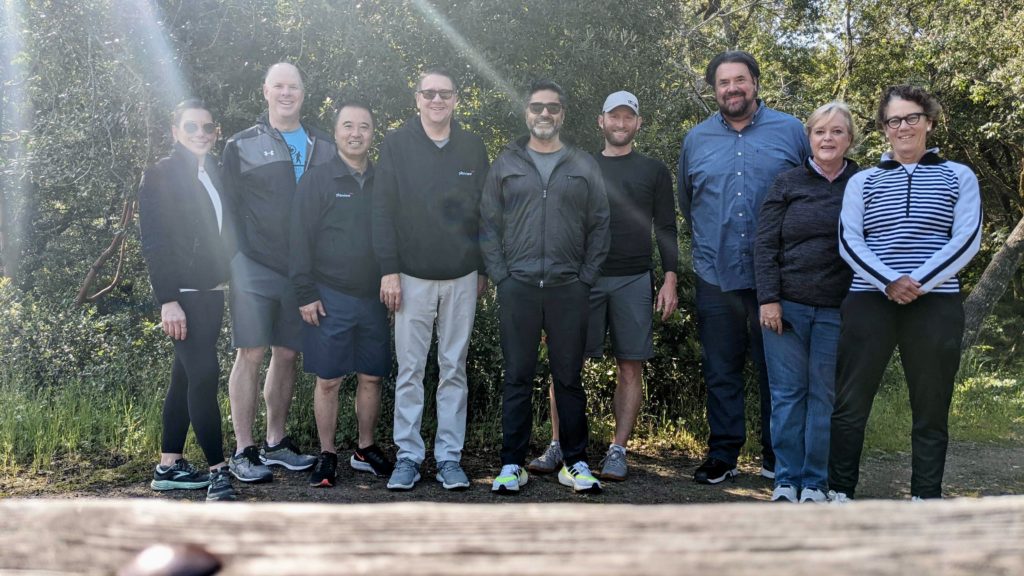
If there’s anything we have collectively learned in the past two years, it’s that it takes effort to stay connected. Meeting new people, fostering relationships, building trust, collaborating – they’re all certainly possible in a hybrid / remote environment, but they require deliberate, consistent effort.
At Planview, we’re very invested in helping businesses stay connected; our mission, which we repeat and display wherever we can, is to build the future of connected work.
To me, this includes being connected as people around a common purpose; those people being connected to a shared strategic vision; and that vision being connected to the market and context it is in (which, of course, changes over time).
Connection, alignment, trust, and how they relate to strategy and organizational effectiveness – these were the topics on everyone’s minds at our recent leadership team offsite meeting.
Through deep discussions in meeting rooms and on hiking trails, we reflected on the importance of connection, building trust, and the new kind of leadership required moving forward.
Prioritizing Connection Within Our Leadership Team
Our leadership team, in its current makeup, has been working together for about 10 months, mostly in a hybrid environment. This is why, from the beginning, we have been intentional about carving out time to meet face-to-face away from the urgency of daily work: Once a month at Planview headquarters in Austin, and for offsite meetings as well to bond and check alignment across the organization.
Our most recent offsite meeting reinforced something that we know to be true:
In order to be aligned, you have to be connected. In order to stay aligned, you have to stay connected – which means you have to build structures, systems, and processes that enable you to stay connected.
This need for alignment, for connectedness, has already been creeping in over the past decade; but the pandemic, and the resulting, sudden shifts to how we work and live and connect kicked everything into overdrive.
At the offsite, we talked a lot about the divide we’re seeing between the organizations who “get it” and those who don’t: Those who understand the critical importance of connectedness moving forward, who are prioritizing alignment, connection, and being mission-driven above all else; and those who see the shifts caused by the pandemic as temporary, who assume things will “go back” to how they were before everything changed (and who are struggling as a result).
After leaving the offsite, I couldn’t help but think about how so many of the “stickiest” moments of the meeting – the ones that made a lasting impression – aligned with our Core Values, which we recently refreshed to reflect our vision.
We take our mission (but not ourselves) seriously.
We are passionate about building the future and helping our customers succeed. And we create the space to be yourself, every step of the way.
Building a culture that is positive, forward-thinking, innovative – it requires a foundation of trust and emotional safety. The corporate culture of yesteryear might not see the value of play, fun, or laughter – activities that might have collectively been referred to as “goofing off” or “slacking on the job.”
But at Planview, we know that teams who play together and laugh together are infinitely more equipped to handle conflict together in a healthy way. They can engage in difficult conversations and come out of them stronger. They have the foundation of trust from which they can feel safe to experiment, try things, and fail – all key ingredients for business agility.
As leaders, we have to set the example of how to take our mission – but not ourselves – seriously. When a few leaders cracked jokes at my expense during one bonding activity and messed with our logo/brand/templates to ‘get my goat’ in another, I knew that they were laughing with me, and not at me. This sense of kinship and mutual trust continued as we engaged in what I like to call “spicy” conversations – and led to some realizations that seriously moved the needle.
We build together.
We continuously innovate and pursue new ideas that are worthy of our teams and customers. We learn and explore together – and when things don’t go as planned, we have each other’s backs.
From a strong foundation of trust and mutual respect, you can start to build, learn, and explore together. In our hyper-productive, “hustle” culture, it takes courage to prioritize the creation of value over everything else.
This is why, as leaders, we have to show, by example, that it’s okay to break a few rules in the name of creating value, in the name of innovation. A small example of this was when we were having timed breakout discussions on a variety of topics. Although we were out of allotted time for one topic, it was clear that we were not done discussing it – there was more value to be uncovered, all we needed was time. So, we decided to prioritize the creation of value over sticking to the agenda – and had some fascinating discussions as a result.
We value our differences.
We champion diverse perspectives, shared belonging, and uncompromising respect for each other. We believe diversity, equity, and inclusion are foundational to our ability to thrive.
At Planview, we know that our greatest asset is our people – and we know that our most important challenge as leaders is to help our people thrive. We believe in the power of diverse perspectives, and know that hiring people with a variety of backgrounds and experiences is just the first step toward creating a truly inclusive working environment.
The real challenge is to not just invite diverse perspectives to the table, but create a culture where everyone feels safe to openly share, debate, experiment, and learn together.
I think two things have to be true for that to be the case: First, there has to be an uncompromising respect for people embedded into the fabric of the culture. That goes so much deeper than simply not having tolerance for bigotry, hatred, or prejudice – which should (though, sadly often doesn’t) go without saying.
Valuing our differences, to us, means recognizing and acknowledging our differences and genuinely celebrating how much we have to learn from each other. For me as a leader, there is nothing worse than being in a room of people who insist on agreeing with you. Who learns anything in that environment?
Of course, it’s difficult to truly value our differences in perspectives if we don’t know what those differences are – deeply not superficially. This is why we dedicate energy, time, and effort to getting to know each other as people – investing in learning about each other’s personalities, personal journeys, and unique professional experiences – so that we have a deeper understanding of the lens through which each of us is viewing the world.
Second,
there has to be a shared understanding, across the organization, that the goal is always, always, always to create the most value for the customer – to go in the direction that the customer and the data suggest.
Leaders have to set the example of this: Abandoning ego in pursuit of the best idea. Being willing to say, “We thought approach A was the right one, but now that we’ve had a chance to collect more data, it looks like approach B makes more sense,” – and that being a good thing.
We strengthen connections.
We believe anything’s possible when people work together on the things that matter most. We break down silos and collaborate fearlessly across levels, functions, and borders.
I touched on it briefly above, the idea of not just being connected but staying connected. We see this one of the key challenges facing businesses following the pandemic, and one that we are actively working to tackle.
Staying connected goes beyond just having the right tools in your stack that make it possible to connect with those in your organization. Simply giving someone a smartphone will not make them a communication expert, nor will it guarantee that they will call their mother from time to time.
You also have to have structures, systems, and processes in place that ensure that everything is in alignment: Building in this kind of regular, automated check-in to your process means that you’ll be more likely to catch things before they become bigger issues: You’ll be less likely to fall victim to accidental strategic or executional drift.
This is why, at key strategy calibration meetings (we call these Strategic Portfolio Management meetings), we take time to check alignment between all the various parts of the business. And it’s always valuable: One of my peers alerted me to the fact that the mix of content our marketing team had been sharing on social media wasn’t fully aligned with our agreed direction.
It takes humility to hear that kind of feedback and not take it a little personally – what do you mean the marketing isn’t perfect, I’m the CMO! – but because of the supportive, customer-focused, purpose-driven culture our team has created, I accept it with gratitude. I’m grateful to my brilliant peers for caring enough to look into what we’re doing and helping to keep us all aligned. I know that getting their feedback on our work strengthens our connections upwards and outwards – and I know our customers are better for it.
We do the right thing.
We put people first and do what we say we’re going to do. Even when it isn’t easy.
One of my favorite “nuggets” of wisdom our CEO Razat Gaurav shared in our first ever episode of Connected Conversations was:
“Employee success plus customer success is what earns you the right to have shareholder success.”
Investing in your employees, prioritizing the needs of your customers, relearning how you think about leadership – it’s not the easiest path forward. But it is the only one that will allow you to build a sustainably innovative, healthy organizational culture.
And what modern leaders know is that at the end of the day, organizational culture is everything. We’re all just human beings who want to do good work and feel like our contributions matter. And when you create an environment that fosters that – shareholder success is almost inevitable.
Connect with Courage
At Planview, we know that what modern businesses need is connection:
- Between strategy and execution
- Between ideas and impact
- Between opportunities and value
- Between the mission of the organization and the values of the people within it
And, of course – between the individual human beings working together at every level within the organization, and the customers they are working to serve.
Our job as leaders is to champion connection and foster opportunities for connectedness, even if it takes a little courage. This starts with us as individuals, making the effort to foster trust, alignment, and connection with the individuals we work with daily.
Connecting all the parts of your business, and staying connected in this hybrid, post-pandemic world is not only possible – it’s essential. Planview is building the tools to make it possible – and, if we do it right, we will be having a little fun along the way.




